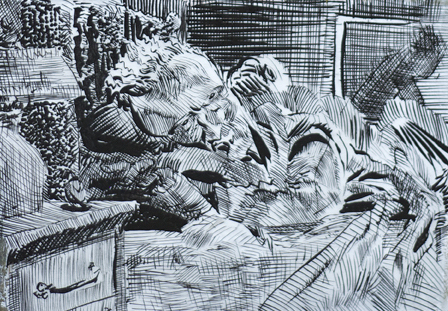Techniques in Black
Black lines are my way of chiseling definition in my acrylic paintings. Lately, I use lines that are alive with variation. It is the line type I witnessed in Japan when contemplating the Japanese calligraphy. The thick black lines in certain Japanese letterforms cover as much area as the white ground. The lines taper drastically, and one line would connect with another at an angle that feels perfect. I make lines that are distant relations to what I found over there.
Comic book artists spot blacks. This is when they choose certain areas in their drawings to cover in black, and they do this to propel certain parts of the image forward and for particular effects, such as creating forms that come out of a pool of black or balancing black areas with the non-black forms. Often, a figure will have almost as much black on it as not, like a silhouette that is partially visible. Having used such heavy-handed methods before, I am now bringing them back into my images to see how they tie things together.
In drawing with a brush, the hatching techniques you use can be more like “feathering.” This is when your parallel lines have more body to them; they taper in ways that are inherent to a brush. I have been looking carefully at woodcuts and wood engravings. There is a similar line there. It is usually a more rigid line, but it has the same taper. The difference is the lines are white instead of black, and yet they create black lines nevertheless; the black resides as the negative spaces of the white — or vice versa. There is also a simplicity to woodcuts that I covet in my complicated thoughts and permutations, in how I constantly turn and turn an idea until it is exhausted. Simplicity is the key to stronger images.
In my old search for styles when I was a youth, I came across two techniques that I used in my drawings. The first one came when I discovered that you can overload a brush or dip pen with ink and draw with thick, wet lines that slipped and thickened all over the drawing. You can manipulate blobs of black and create some of those black areas comic book artists were using. But I was using it in a silkier, more silvery way because I was allowing streaks of white to interplay with the black. Using this overly wet technique, I was imposing a shiny and smooth finish on everything.
A couple of years later, I was also working with broad black areas, and I found a way to give a figure dramatic lighting by infusing certain parts of a figure with pure black. And if you had enough of these black areas creating the figure, you didn’t even need a contour line to tie it together. A viewer would still be able to read these black and white splotches. Later, much later, I would see that this technique I “invented” had been used countless times by other artists, and I am thinking now of Kathe Kollwitz. The nice things about not including certain contour lines is that a drawing can insinuate something through strange juxtapositions without coming out and showing them.
